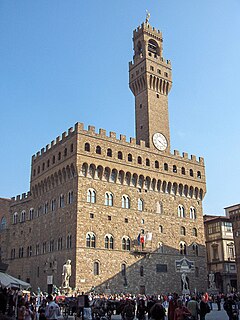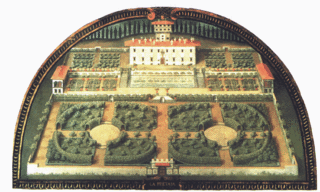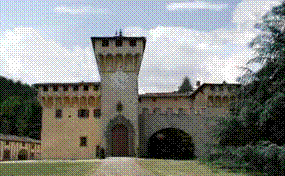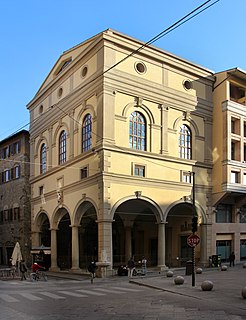This article needs additional citations for verification .(September 2014) |


The Forte di Belvedere or Fortezza di Santa Maria in San Giorgio del Belvedere (often called simply Belvedere) is a fortification in Florence, Italy.
This article needs additional citations for verification .(September 2014) |


The Forte di Belvedere or Fortezza di Santa Maria in San Giorgio del Belvedere (often called simply Belvedere) is a fortification in Florence, Italy.
Forte Belvedere is the second and largest fortress to be built in Florence, Italy.
It was designed and built by Bernardo Buontalenti over a five-year period, between 1590 and 1595, by order of Grand Duke Ferdinando I de' Medici.
Fortifications were significant in the 16th century and a demonstration of a city's wealth and capabilities. [1]
The fortress is located in the southern hills of the Arno River and on the highest hill of the Boboli Gardens. It had long been considered one of the weakest spots in the city's defenses, a sensation that only increased with the invention of artillery in the early modern era. [2] From a military point of view, the fortress is located at the most strategic point, overlooking almost the entire city and surrounding area. [3] Due to the nature of Renaissance warfare, forts were paramount in a city's defensive strategy. [1]
The Fort served several purposes. Most importantly it was designed to protect the centre of government in Florence and the Medici family if the city came under attack. [4] It was also constructed to protect the Pitti Palace, Oltrarno district and south end of the city. [5] In addition to this, the fort served as a garrison for troops for over 100 years after its completion. [5]
Galileo Galilei used Forte Belvedere for his astronomical observations and after he was sentenced to life imprisonment in 1633, he lived not far from the fort in Villa Arcetri. [6]
The design of the fort reflects both Italian Renaissance and military architecture. [7]
Buontalenti's application of contemporary fortification principles is evident throughout the design. The walls are built at angles that allow for all the walls to be seen by another wall, allowing for cross fire to assist in protecting the other walls. [5]
The fort was connected to the Palazzo Vecchio via the Vasari Corridor. There were also passages connecting it to the Pitti Palace and paths leading through the Boboli Gardens. [4]
Frescos seen in the Palazzo Vecchio show an earlier version of the fort, built of earth and stone gabions. [5]
The design of the fort demonstrated the power and prestige of the Medici Family. [8]
The opulent villa at the centre of the fortress, Palazzina di Belvedere, predates the fort and was designed by Bartolomeo Ammannati around 1570. [9] As the fort's secondary purpose was to house the Grand Duke in times of unrest or epidemic, it was built as a comfortable, luxurious palace. It did not adhere to military purposes, housing the Medici family's treasures in the bottom of a well inside the building. [10]
Today the Forte di Belvedere constitutes a monumental, historic, artistic and environmental focal point, offering visitors sweeping views of Florence and an insight to Renaissance architecture and military activity.
After five years of renovation to improve its safety features, the fort reopened to visitors in July 2013. [8]
It serves primarily as a tourist attraction and exhibition centre, hosting elite events and artistic exhibitions year round. [11]
On May 24, 2014, celebrity couple Kim Kardashian and Kanye West paid €300,000 to hire the fort as the venue for their lavish wedding. [8]

Bartolomeo Ammannati was an Italian architect and sculptor, born at Settignano, near Florence. He studied under Baccio Bandinelli and Jacopo Sansovino and closely imitated the style of Michelangelo.

The Ponte Vecchio is a medieval stone closed-spandrel segmental arch bridge over the Arno River, in Florence, Italy. It is noted for the shops built along it; building shops on such bridges was once a common practice. Butchers, tanners, and farmers initially occupied the shops; the present tenants are jewelers, art dealers, and souvenir sellers. The Ponte Vecchio's two neighboring bridges are the Ponte Santa Trinita and the Ponte alle Grazie.

Cosimo I de' Medici was the second Duke of Florence from 1537 until 1569, when he became the first Grand Duke of Tuscany, a title he held until his death.

The Boboli Gardens is a historical park of the city of Florence that was opened to the public in 1766. Originally designed for the Medici, it represents one of the first and most important examples of the Italian garden, which later served as inspiration for many European courts. The large green area is a real open-air museum with statues of various styles and periods, ancient and Renaissance that are distributed throughout the garden. It also has large fountains and caves, among them the splendid Buontalenti grotto built by the artist, architect, and sculptor Bernardo Buontalenti between 1536 and 1608.

The Palazzo Vecchio is the town hall of Florence, Italy. It overlooks the Piazza della Signoria, which holds a copy of Michelangelo's David statue, and the gallery of statues in the adjacent Loggia dei Lanzi.

The Palazzo Pitti, in English sometimes called the Pitti Palace, is a vast, mainly Renaissance, palace in Florence, Italy. It is situated on the south side of the River Arno, a short distance from the Ponte Vecchio. The core of the present palazzo dates from 1458 and was originally the town residence of Luca Pitti, an ambitious Florentine banker.

Bernardo Buontalenti, byname of Bernardo Delle Girandole, was an Italian stage designer, architect, theatrical designer, military engineer and artist and inventor of italian ice cream.

The Loggia dei Lanzi, also called the Loggia della Signoria, is a building on a corner of the Piazza della Signoria in Florence, Italy, adjoining the Uffizi Gallery. It consists of wide arches open to the street. The arches rest on clustered pilasters with Corinthian capitals. The wide arches appealed so much to the Florentines that Michelangelo proposed that they should be continued all around the Piazza della Signoria.

Giusto Utens or Justus Utens was a Flemish painter who is remembered for the series of Medicean villas in lunette form that he painted for the third Grand Duke of Tuscany, Ferdinando I, in 1599–1602.

The Villa Medicea di Cafaggiolo is a villa situated near the Tuscan town of Barberino di Mugello in the valley of the River Sieve, some 25 kilometres north of Florence, central Italy. It was one of the oldest and most favoured of the Medici family estates, having been in the possession of the family since the 14th century, when it was owned by Averardo de' Medici. Averardo's son, Giovanni di Bicci de' Medici, is considered to be the founder of the Medici dynasty.

The Villa di Pratolino was a Renaissance patrician villa in Vaglia, Tuscany, Italy. It was mostly demolished in 1822. Its remains are now part of the Villa Demidoff, 12 km north of Florence, reached from the main road to Bologna.

The Vasari Corridor is an elevated enclosed passageway in Florence, central Italy, connecting the Palazzo Vecchio with the Palazzo Pitti. Beginning on the south side of the Palazzo Vecchio, it joins the Uffizi Gallery and leaves on its south side, crossing the Lungarno dei Archibusieri, then following the north bank of the River Arno until it crosses the river at Ponte Vecchio. At the time of construction, the corridor had to be built around the Torre dei Mannelli, using brackets, because the tower's owners refused to alter it. The corridor conceals part of the façade of the Church of Santa Felicità. It then snakes its way over rows of houses in the Oltrarno district, becoming narrower, to finally join the Palazzo Pitti. The corridor's full length is approximately one kilometre.

The Medici villas are a series of rural building complexes in Tuscany which were owned by members of the Medici family between the 15th century and the 17th century. The villas served several functions: they were the country palaces of the Medici, scattered over the territory that they ruled, demonstrating their power and wealth. They were also recreational resorts for the leisure and pleasure of their owners; and, more prosaically, they were the centre of agricultural activities on the surrounding estates. In 2013, the Medici villas were added to UNESCO's World Heritage list.
Piazzale Michelangelo is a square with a panoramic view of Florence, Italy, located in the Oltrarno district of the city.

The historic centre of Florence is part of quartiere 1 of the Italian city of Florence. This quarter was named a World Heritage Site by UNESCO in 1982.

Alessandro Pieroni was an Italian architect and painter. He was active mainly in a Mannerist style, working for the courts of Grandukes Francesco I and Ferdinando I de' Medici, Grand Duke of Tuscany.

The Palazzo di Bianca Cappello, originally belonging to Corbinelli family is a Renaissance-style palace located on Via Maggio #26 of the quarter of Oltrarno in Florence, region of Tuscany, Italy. It is notable for its facade decoration, and once housing Bianca Cappello, the mistress, then wife of the Grand-Duke Francesco I de' Medici

The Loggia del Grano is a 17th-century rectangular building with an open ground floor arcade, located on Piazzetta del Grano, at the corner of via de' Neri and via de' Castellani, just southeast of the Palazzo Vecchio, in Florence, region of Tuscany, Italy; the portico served as the marketplace for grains while the upper stories were used for storage.

The church of San Giorgio alla Costa, called in earlier times also dei Santi Giorgio e Massimiliano dello Spirito Santo is a small historical church in the Oltrarno district of the centre of Florence, situated on the steep slope of via Costa San Giorgio which runs uphill from Ponte Vecchio to Forte di Belvedere.

The Museums of Florence form a key element of the cultural and artistic character of the city. Of the 15 most visited Italian art museums and galleries, five are in Florence. The number and proximity of the works of art in the museums of Florence can trigger the Stendhal syndrome on visitors who try to see them all, as evidenced by hospital records of hundreds of visitors each year affected by the syndrome. The art in Florence was one of the elements that contributed to the central part of the city being named a UNESCO World Heritage Site.
{{cite web}}: CS1 maint: archived copy as title (link)Coordinates: 43°45′48″N11°15′13″E / 43.763447°N 11.253519°E